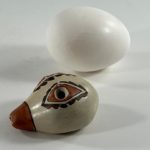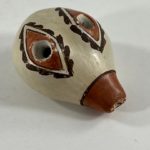I bought my first Hopi-Tewa pot 65 years ago, have been collecting ever since, have a large research library, and have been working on this catalog for more than 20 years. I consider myself quite an expert when it comes to pottery from Hopi, especially if the pottery involves the Nampeyo family. The nice thing about hubris is that it generally entangles its owner, with often dramatic and public results. Such is the moral tale of this catalog entry. The title of this entry used to be “Kitsch tourist whistle.” Before I knew the provenance of the whistle this catalog entry read:
“Of the ten Daisy pots in this collection, pot 2022-01 is the most aesthetically inconsequential. To be sure, it will make a child smile and is the only pot of the ten that can make sound, but it is merely a trinket. Some of the Daisy pots in this collection are masterpieces (2019-16) and some particularly innovative (2011-13). Museums and wealthy collectors have good reason to celebrate the masterpieces in their Hopi pottery collections, but for the artists making pottery was a livelihood. Sales of huge or elaborate pieces provided larger infusions of income, but more consistent income was generated by selling small, inexpensive pieces to tourists. Daisy’s ant pot (2015-07) with its appealing story was designed for the tourist market. It’s cute, but whistle 2022-01 pushes the boundary from “cute” to tourist “kitsch.”
Now here’s the provenance, which establishes that all of my assumptions about this whistle —every one of them— was wrong:
“The whistle was a gift to me after a pow wow where Sydney Hooe the husband of Daisy Nampeyo danced etc. This was at Zuni Pueblo in 1967 or 1968. She made several of these that the elders blew during the ceremonies . I knew Daisy and Sydney for about 15 years as I curated an exhibition of her work and the work of Maria Chino ( Acoma Pueblo) for the de Young Museum.”
—- Elsa Cameron (Seller)
Ah, well…..that being the case……. it is no longer kitsch; my understanding has shifted radically. Now it’s an “authentic” Native material cultural artifact because it was made for use within its culture. The object itself never changed, while my understanding of it changed radically. It’s an Aesop-like tale with an instructive moral lesson having something to do with collectors and humility.
Form:
Held in the hand, this whistle feels like a small, smooth stone. It is tear-drop shaped, flat on one side and domed on the other. About midway along its domed side there are two small finger holes. A third hole at the tip allows air to enter. A fourth hole on the bottom allows air to escape.
The whistle is made of white Zuni clay and has probably been slipped with the same material on the outside and then polished with a polishing stone.
Design:
Each of the holes on the domed side are treated as if they were eyes. Each is surrounded by a red lens-shaped element, itself surrounded by a fringe of 12 short lines, sort of like eyelashes. The thin tip of the whistle is painted red leading up to the blow hole. A thin black line separates the unpainted body from the red tip. The bottom hole is unpainted.
The whistle is signed on the bottom “Daisy Nampeyo.”
Design analysis:
When these few elements of form and painting are consolidated, the result is a whistle in the form of a duck head. The whistle might have been made for use during a ceremony at Zuni, but is makes a very soft sound when blown. The kachinas and spirits would have to be listening very carefully to hear these soft prayers. Then again, the dance might have been designed to teach us to listen carefully to soft voices.





